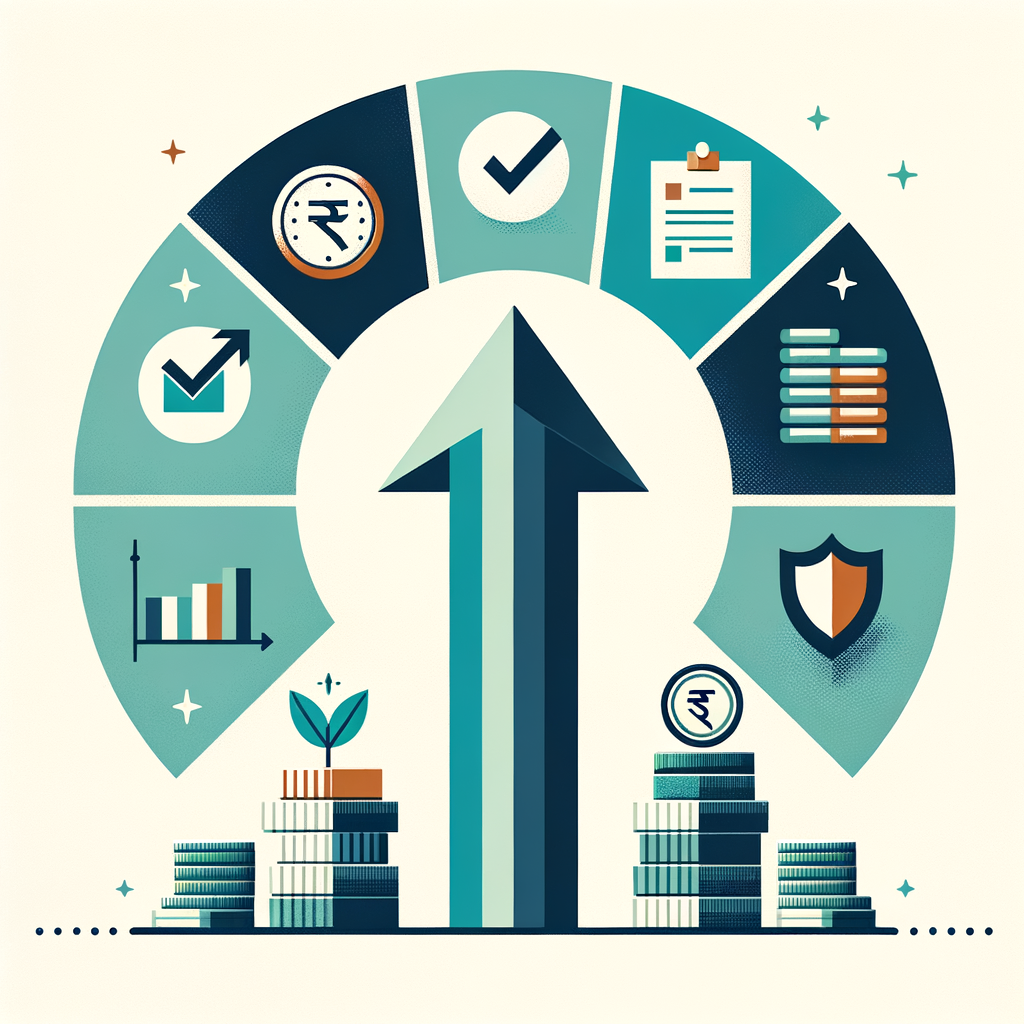How to Bounce Back After Bankruptcy: Debt Management Tips
Facing bankruptcy is one of the most stressful financial experiences anyone can endure in India. The weight of creditor calls, legal proceedings, and financial uncertainty can feel overwhelming. However, it’s crucial to view this moment not just as an end, but as a forced reset—an opportunity to build a new, stronger financial foundation from the ground up. This guide is designed to be your roadmap, providing clear, actionable debt management tips and proven recovery strategies. We will walk you through the immediate aftermath, the critical first steps, and the long-term plan you need to regain control, offering practical advice on how to manage debt in India and pave the way for a secure future. Whether you’re a salaried individual or a small business owner, these bankruptcy recovery strategies India will help you navigate the path to financial stability.
Understanding the Aftermath: What Happens After Bankruptcy in India?
Before you can rebuild, you must understand the new landscape you are operating in. The period immediately following a bankruptcy discharge is a strange mix of relief and uncertainty. The constant pressure from creditors may be gone, but new challenges related to your financial identity and creditworthiness have emerged. Acknowledging these realities is the first step toward creating a realistic recovery plan. It’s not about being pessimistic, but about being prepared for the practical hurdles you will face. This understanding allows you to set achievable goals and manage your expectations, preventing future disappointment and helping you focus on the concrete actions that will genuinely aid in overcoming bankruptcy in India. This section will clarify the legal and financial context, setting the stage for your comeback story.
The Legal Reality: A Brief on the Insolvency and Bankruptcy Code (IBC)
For individuals, proprietorships, and partnership firms in India, the relevant legislation is the Insolvency and Bankruptcy Code (IBC), 2016. This code provides a formal, time-bound process for resolving insolvency. When you go through this process and the adjudicating authority (like the Debt Recovery Tribunal) is satisfied, you are granted a “discharge.” In simple terms, a discharge is a legal order that releases you from the obligation to repay most of your previous unsecured debts, such as personal loans and credit card balances. It effectively wipes the slate clean for those specific liabilities, preventing creditors from taking any further collection action against you for them. This legal finality is the cornerstone of your fresh start. For detailed legal provisions and official information, you can refer to the Insolvency and Bankruptcy Board of India (IBBI) website.
The Impact on Your CIBIL Score and Financial Life
While a discharge clears your debts, it leaves a significant mark on your financial record. Your CIBIL score, a three-digit summary of your credit history, will be severely impacted. The bankruptcy will be noted on your credit report for approximately seven years, and your score will likely drop to the lowest possible range. This has very real-world consequences. For the next several years, accessing new credit will be extremely difficult, if not impossible. Mainstream banks will be hesitant to offer you personal loans, car loans, or standard credit cards. You might also face challenges in other areas, such as finding a rental property, as landlords increasingly run credit checks. Understanding this is not meant to discourage you but to prepare you for the patient and deliberate effort required to rebuild your creditworthiness and regain the trust of financial institutions.
Your First 90 Days: Essential Steps for Immediate Recovery
The first three months after your bankruptcy discharge are critical. The actions you take during this period will set the tone for your entire financial recovery. This isn’t the time for complex investment strategies or long-term financial goals; it’s about stabilization and control. Think of it as financial triage—addressing the most urgent needs to ensure your immediate survival and create a stable base from which to grow. By focusing on these fundamental steps, you can prevent yourself from falling back into old habits and start building the discipline required for long-term success. These foundational actions provide immediate financial recovery tips for Indians looking to make a clean break from the past.
Step 1: Create a Post-Bankruptcy Survival Budget
Your single most powerful tool for recovery is a budget. Specifically, a zero-based budget. This method requires that every single rupee of your income is assigned a job—nothing is left unallocated. Your income minus your expenses, savings, and any other outflows must equal zero. This forces you to confront your spending habits and make conscious decisions about where your money goes. Start by listing all your sources of income. Then, create two categories for expenses: Essentials and Non-Essentials. Essentials are non-negotiable costs like housing (rent/EMI), basic groceries, utilities (electricity, water), and transportation to work. Non-Essentials include everything else: entertainment, dining out, subscriptions, and shopping. In this initial phase, your goal is to ruthlessly cut non-essential spending to ensure your essential needs are met and you have a clear picture of your cash flow.
Here is a sample zero-based budget for a monthly income of ₹40,000:
| Category | Allocation (₹) | Notes |
|---|---|---|
| Income | +40,000 | Post-tax monthly salary |
| Expenses | ||
| Rent | -12,000 | Essential Housing |
| Utilities | -2,500 | Electricity, Water, Gas |
| Groceries | -8,000 | Basic food items, no luxuries |
| Transportation | -3,000 | Public transport or fuel for work |
| Phone/Internet | -1,000 | Basic plan |
| Savings (Initial) | -500 | Start of an emergency fund |
| Discretionary | ||
| Personal Care | -1,000 | Toiletries, essential items |
| Buffer/Misc. | -2,000 | For unexpected small expenses |
| Total Outflow | -30,000 | Example has a surplus to allocate |
| Remaining | 10,000 | Must be allocated to savings/goals |
| Final Allocation | ||
| Emergency Fund | -10,000 | Allocate remaining to savings |
| Net Balance | ₹ 0 | Every rupee has a job |
Step 2: Open a New, Clean Slate Bank Account
It is highly advisable to open a new, basic savings account at a bank where you did not have any debts that were included in the bankruptcy. This serves two critical purposes. First, it creates a psychological and practical separation from your past financial troubles. Operating out of a fresh account helps reinforce the “clean slate” mindset. Second, it prevents any potential complications or accidental freezing of funds that could arise if you continue using an account with a bank to whom you previously owed money. Choose a simple, no-frills savings account, preferably with a public sector bank or a reputable private bank that offers zero-balance facilities. This new account will be the central hub for your post-bankruptcy budget, where your income is deposited and from which you pay all your carefully planned expenses.
Step 3: Organize All Your Discharge Paperwork
The legal documents you receive upon the discharge of your bankruptcy are invaluable. Do not underestimate their importance. You must keep all court-issued orders, lists of discharged debts, and any related correspondence in a safe, organized, and easily accessible file. These papers are your official proof that you are no longer legally obligated to repay those debts. In the future, you may encounter administrative errors where a creditor’s system mistakenly tries to collect an old debt, or an old negative item may reappear on your credit report. Your discharge paperwork is the ultimate evidence you can present to correct these errors quickly and efficiently. Make both physical and digital copies (scanned and saved to a cloud service) to ensure you are always protected.
Rebuilding Your Finances: Proven Debt Management Tips for Long-Term Stability
Once you have stabilized your immediate situation, it’s time to shift your focus from survival to long-term rebuilding. This phase is a marathon, not a sprint. It requires patience, consistency, and a commitment to developing healthy financial habits that will serve you for the rest of your life. The goal here is not just to get by, but to build a resilient financial future where you are in complete control. This section provides the core debt management tips that form the pillars of sustainable financial health. Many of these principles are also covered in our guide on how debt management can be effectively included in personal financial planning. Implementing these tips for financial stability after bankruptcy will be crucial in transforming your financial narrative from one of hardship to one of success and security.
Master the Art of Budgeting and Cash Flow
The survival budget from your first 90 days was about control; your long-term budget is about growth. As your situation stabilizes, you can transition to a more balanced budgeting model like the 50/30/20 rule. This framework suggests allocating 50% of your after-tax income to Needs (rent, utilities, groceries), 30% to Wants (entertainment, hobbies, dining out), and 20% to Savings and Debt Repayment. This rule provides a sustainable structure for managing your money without feeling overly restricted. To make this work, you must continue to track every single rupee of your spending. Use a personal finance app, a dedicated spreadsheet, or even a simple notebook. This meticulous tracking is the best preventative measure and the most effective way to how to manage debt in India in the future—by ensuring you never again spend more than you earn.
Build an Emergency Fund (Your Financial Shield)
One of the most common reasons people fall into debt is the lack of a safety net for unexpected expenses. A medical emergency, a major car repair, or sudden job loss can quickly spiral into a financial crisis without savings to fall back on. Therefore, building an emergency fund is a non-negotiable step in your recovery. This fund should be liquid, meaning it’s held in a separate, easily accessible savings account, not invested in the market. Start small. Your first goal could be to save ₹10,000. Once you hit that, aim for one month of essential living expenses. Your ultimate goal should be to accumulate enough to cover 3-6 months of essential living costs. This fund is your shield; it protects you from having to take on new debt when life throws you a curveball and is a cornerstone of financial stability after bankruptcy.
Strategically Rebuild Your CIBIL Score
Rebuilding your CIBIL score after bankruptcy is a slow and deliberate process. Since you won’t qualify for traditional loans or credit cards, your best tool is a Secured Credit Card. This is a special type of credit card that is backed by a fixed deposit (FD) you place with the bank. The credit limit is typically 80-90% of the FD amount. This eliminates the risk for the bank and allows you to start building a new line of positive credit history. Here’s how to use it effectively:
- Apply for a secured card with a small FD (e.g., ₹20,000).
- Use it for one small, planned purchase each month (like your mobile phone bill or a single utility payment).
- Pay the entire bill in full well before the due date. Never carry a balance.
- Monitor your credit report to ensure this positive payment history is being reported to the credit bureaus.
This disciplined usage demonstrates to lenders that you can now manage credit responsibly. You can and should check your credit score regularly through official channels like the CIBIL website to track your progress. A key part of this is knowing how to track your credit history using your PAN card via CIBIL.
Tailored Advice: Bankruptcy Help for Salaried Individuals & Business Owners
While the core principles of financial recovery are universal, the specific application of these strategies can differ based on your source of income. A salaried individual with a predictable monthly income faces different challenges and opportunities than a small business owner with variable cash flow. Recognizing these differences is key to creating a recovery plan that is not only effective but also realistic for your specific situation. This section provides targeted bankruptcy help for salaried individuals and practical debt recovery solutions for Indians who run their own businesses.
Financial Recovery Tips for Salaried Individuals
For a salaried person, the predictability of your income is your greatest asset. Your primary focus should be on maximizing the savings potential of your fixed paycheque. The most effective strategy is to “pay yourself first.” Set up an automatic transfer (a standing instruction) with your bank to move a fixed percentage of your salary—say, 10-20%—into your emergency fund savings account the day you get paid. This automates your savings and removes the temptation to spend the money first. In case of a dire emergency where your nascent emergency fund is insufficient, explore options other than high-interest personal loans. Consider speaking with your HR department about the possibility of a salary advance or an interest-free loan from your employer, which is a much safer alternative to getting back into the debt cycle.
Debt Recovery Solutions for Small Business Owners
For small business owners, bouncing back after bankruptcy often means restarting from scratch. The key is to adopt a “lean business model” in your new venture. This means keeping overheads as low as possible. Consider working from a co-working space instead of leasing an expensive office, using freelance talent instead of hiring full-time staff initially, and leveraging free or low-cost digital marketing tools. Meticulous financial hygiene is paramount. From day one of your new business, separate your business and personal finances completely. It’s crucial to set up an accounting system for my small business and maintain diligent records of every single transaction using reliable accounting software. This discipline will not only prevent a repeat of past mistakes but also be crucial when you eventually want to apply for business loans. After a few years of clean financial operations, explore government schemes for Micro, Small, and Medium Enterprises (MSMEs) that offer financial assistance and support. You can begin by registering your new venture on the Udyam Registration Portal for MSMEs.
Conclusion
Bouncing back from bankruptcy is a journey of discipline, patience, and strategic planning. It begins with understanding the new financial reality you face and taking immediate control of your cash flow with a strict survival budget. From there, the path to recovery is paved with consistent, positive habits. By applying long-term debt management tips—such as building a robust emergency fund to act as your financial shield and methodically rebuilding your credit score with a secured card—you can transform your financial future. Remember, bankruptcy is not a life sentence; it is a legal tool designed to give you a fresh start. With the right mindset and the proven strategies outlined here, achieving lasting financial health and overcoming bankruptcy in India is not just a dream, but an entirely achievable reality.
The path to financial recovery can feel complex. For personalized guidance on debt management tips India and expert support in rebuilding your financial life, contact TaxRobo’s financial advisory team today. Let us help you plan your comeback.
Frequently Asked Questions (FAQs)
1. How long will bankruptcy affect my CIBIL score in India?
A bankruptcy record typically stays on your CIBIL report for 7 years from the date of discharge. However, its negative impact is most severe in the initial years and gradually lessens over time. As you begin to demonstrate responsible financial behavior, such as by making consistent, on-time payments on a secured credit card, you can slowly start to rebuild your score even while the bankruptcy record is still present.
2. Can I get a home loan or car loan after bankruptcy in India?
It is very difficult to get approved for a major loan like a home loan or car loan in the first 2-3 years following a bankruptcy discharge. Mainstream lenders will see you as a high-risk applicant. Before they consider your application, they will want to see a significant period of stable income, a rebuilt emergency fund, and a proven track record of positive credit history, which you can establish using secured credit cards and small, secured loans.
3. What is the single most important tip for overcoming bankruptcy in India?
The single most important tip is to create and strictly adhere to a realistic, detailed budget. Budgeting is the foundation upon which all other recovery efforts are built. It gives you absolute control over your cash flow, prevents overspending, enables you to build savings for emergencies, and provides the financial discipline needed to rebuild your credit and your life.
4. Are all my debts cleared in bankruptcy?
Most unsecured debts, such as personal loans, credit card bills, and medical bills, are typically discharged in a bankruptcy proceeding. However, not all debts are eligible for discharge. Certain obligations, such as child support, alimony, some student loans, and certain tax liabilities, may survive the bankruptcy. It is crucial to refer to your official discharge paperwork, which will explicitly list the debts that have been cleared.



